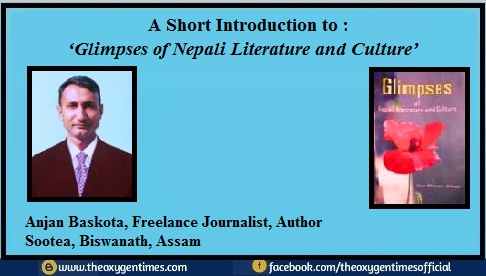A Short Introduction to : ‘Glimpses of Nepali Literature and Culture’
Anjan Baskota, Freelance Journalist, Author, Sootea, Biswanath, Assam
Introduction:
Title of the book: Glimpses of Nepali Literature and Culture
Name of the author: Gyan Bahadur Chhetry
Name of the Publisher: Oriental Publication Pvt. Ltd, Kathmandu
Edition: 2020 (First)
Price: 250 INR.
Genre: Critical Essays (in English)
About the author:
Gyan Bahadur Chhetry is a prominent critic from Tezpur, Assam. He has many books to his credit. They include Avalokan (Nepali 2016, criticism), Sahitya Akademi Puraskar Vijeta Nepali Sahityakar (Nepali, 2000), Sarjak Ra Srijana (Nepali, 2010, criticism), Sagarmathako Deshma (Nepali, 2018), Nepali Sahityat Ebhumuki (Assamese, 2010), Phulam Gamocha Aru Anyanya Rachana (Assamese, 2016). G.B.Chhetry is a prolific writer who has equal reach in English, Assamese, Nepali and in Hindi languages. He has already served as an advisory member of the Nepali language for Sahitya Akademi for two consecutive terms. A recipient of Sahitya Akademi translation award for his translation work ‘Khoji’ in 2016. Sri Chhetry is a known translator. His translation works cover Manpareka Katha (Nepali, 2003), MailoChadar (Nepali, 2010), Khoji (Nepali, 2010). And Glimpses of Nepali Literature and Culture is his first published book in the English language. About the book: ‘Glimpses of Nepali Literature and Culture’ is a collection of twenty essays including critical articles, seminar papers, features, book reviews, biographical sketches etc. The first article of this collection is ‘A brief history of Nepali literature’. Here, the narrator has traced the origin, growth and developmental stages of Nepali literature following narrative style. He has separated the history of Nepali literature into different stages such as Adikal, Madhyamik Kal, Adhunik Kal along with a brief history of different literary trends and genres. ‘Contemporary Indian Nepali Literature’ is the second article of this collection. The author has sub-divided this chapter as fiction, essays, drama criticism, children literature, translation and tries to assemble the contributions of the concerned authors in respective fields of genres. ‘Youth Writing: Nepali Literature with Prime focus on N.E Region’ is the article placed in the third position. Here, the young and talented writers contributions in various types of literature such as poetry, fiction, essays, drama, criticism etc have been traced. Though, the age bar for being recognized as a youth writer in this article has not been mentioned by the author. Though, many names of young writers from this fertile region of literature have not been included. The role of Sahitya Akademi for motivating young writers has been quickly recapped here. An introduction about ‘History and Culture of Assamese-Nepali’, a research book published by the department of Historical and Antiquarian Studies; Assam has been inserted in the fourth place. A total of eleven biographical sketches covering the life, contributions of the eminent figures have been placed herein. The life sketches cover the life story of Laxmi Prasad Devkota, Indra Bahadur Rai, Shiva Kumar Rai, Puspalal Upadhyaya, Hari Prasad Gorkharai, Haribhakta Katuwal, Bishnulal Upadhyaya, Prabhuram Karki, Padmasree Lil Bahadur kshatri, Gita Upadhyaya, Nar Bahadur Bhandari. As a fifteenth article a critical analysis of ‘History of Modern Indian Nepali Literature’ penned by Dr. Jiwan Namdung and published by Sahitya Akademi in 2019 has been inserted. Similar articles carrying critical analysis of books include ‘Of Myriad Voices’, ‘Sparks Inside’ which were included in sixteenth and seventeenth numbers. The eighteenth article titled as ‘Some Indigenous Food Products and Beverages’ is an essay with separate theme and variety having no direct relation with Nepali literature, yet shows rich cultural heritage and ethnic tastes and flavors of the Gorkha community. The last article of the collection is ‘Struggle for recognition of Nepali Language: a brief outline’. The Indian Gorkhas had to struggle for long 36 years for constitutional recognition of the Nepali language. The author, through this article traces the history of language movement and pays a rich tribute to the martyrs here in. Conclusion: ‘Glimpses of Nepali Literature and Culture’ is the first book published in the English language from the North East region that carries the literary history of Nepali language. Secondly, the author of the book is seen judicious towards demarcation of Indian Nepali literary history from the history of Nepali literature including the history of Nepal at a large. The concept of the author is noticed clearly while going through the book that the author tries to segregate the history of Indian Nepali literature from that of the history of Nepali literature in total. He is seen trying his best in erecting the history of Indian Nepali literature with fragrance of Indian soil.
Prof. Dr. Govinda Raj Bhattarai, a versatile litterateur from Kathmandu, Nepal has appreciated the author’s effort in the preface of the book. The language used by the author is very simple and up-to the mark of general reader. The technique of analysis is narrative and references are applied following modern trend and methodology of research books. Though it cannot be claimed that ‘Glimpses of Nepali Literature and Culture’ book of pure history of Nepali literature and culture, but may term it as a reference book for the same. As it is the first book of the author in English language, the author may compile books on history of Nepali literature. It would be better if the obituary, biographical write-ups, memoirs etc to pile up in a separate book. Further, book review is a purely separate genre of literature. At the end, I must say everybody should read this book for comprehensive knowledge about the Nepali literature.
(Anjan Baskota, Samar Dalani, Sootea, Biswanath, Assam: 784175, Ph: 7002702268)

Post a Comment